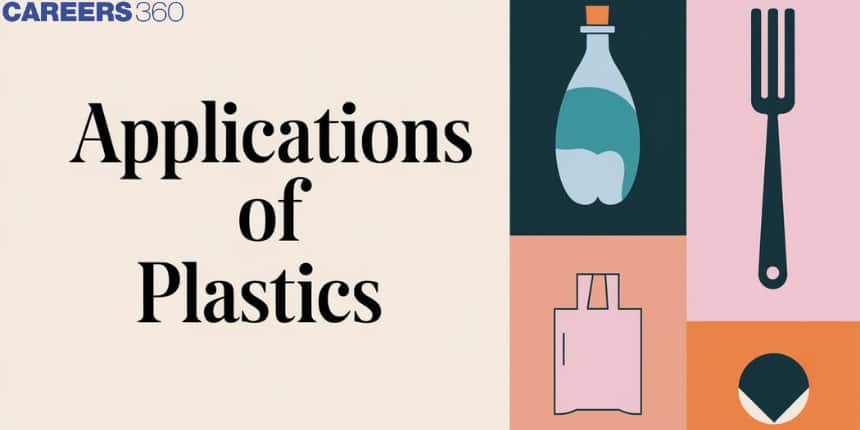Applications Of Plastics: Properties, Uses, Packaging, Facts, FAQs
Plastics are a category of semi-synthetic or synthetic substances that contain polymers as their primary component. Plasticity during the manufacturing process allows the plastic to be moulded, extruded, or pressed into solid objects of various shapes and it also allows the material to adapt accordingly and is useful in a wide range of applications.
NEET 2025: Mock Test Series | Syllabus | High Scoring Topics | PYQs
JEE Main: Study Materials | High Scoring Topics | Preparation Guide
JEE Main: Syllabus | Sample Papers | Mock Tests | PYQs
- Properties of Plastics
- Uses of Plastics
- Facts about Plastics

This adaptability, combined with a wide range of advantageous properties like lightweight, durability, flexibility and also low-cost manufacturing methods, has contributed to widespread acceptance in modern society. The majority of modern plastics are derived from petrochemicals which are derived from fossil fuels like natural gas or petroleum. This is the most recent plastic manufacturing process, on the other hand, the use of alternatives which is made from renewable materials like corn or cotton derivatives.
Properties of Plastics
Plastics are commonly solids, they can be amorphous, crystalline, or semi-crystalline solids also known as crystallites.
Plastics are typically poor in heating and electricity conductors and mostly are dielectrically strong insulators.
Glassy polymers are typically stiff like polystyrene. These are thin sheets of polymers, on the other hand, can be used as films also (e.g., polythene).
When stressed, it is near all the plastics which exhibit elongation that does not recover after the stress is removed and this is referred to as “creep.”
Plastics are mostly long-lasting and degrade at a slow rate.
Uses of Plastics
At Homes
There is a significant amount of plastic in television, sound systems, cell phones, vacuum cleaners, and most likely in the plastic foam in the furniture, etc.
Plastic chair or bar stool seats, acrylic composite counter-tops, PTFE linings in nonstick cooking pans, and plastic plumbing in the water system also.
Automotive and Transport
Plastics have contributed to many of the innovations in automotive design, like improvements in safety, performance, and fuel efficiency.
Plastics are also used in trains, planes, automobiles, and even ships, satellites, and space stations. Bumpers, dashboards, engine components, seating, and doors are a few examples of plastic.
Construction Sector
Plastics are used in a number of ways in the construction field because they have a high degree of versatility and combine excellent strength-to-weight ratio, durability, cost-effectiveness, low maintenance, and corrosion resistance which make plastics an economically appealing choice in the construction industry.
Packaging
A variety of plastics are used to package, deliver, store, and serve food and beverages, etc. Plastics are also used in food packaging which are chosen for their performance because they are inert and chemically resistant to both the outside environment and the foods and beverages themselves.
Many of today’s plastic containers and wraps are mostly designed to withstand microwave heating temperatures.
Many plastic food containers have the added benefit of being able to safely transition from freezer to microwave to dishwasher also.
Sports Safety Gear
Sports safety equipment is lighter and stronger like plastic helmets, mouth guards, goggles, and protective padding, to keep everyone safe.
Moulded, shock-absorbent plastic foam keeps feet stable and supported, and tough plastic shells covering helmets and pads protect heads, joints, and bones etc.
Medical field
Plastics have been widely used in medical tools and devices like surgical gloves, syringes, insulin pens, IV tubes, catheters, inflatable splints, blood bags, tubing, dialysis machines, heart valves, artificial limbs, and wound dressing, among others.
Facts about Plastics
Bakelite is the first completely synthetic plastic which was created in 1907 by Leo Baekeland, he coined the term “plastics.”
The term “plastic” is derived from the Greek word plastikos. This means “able to be shaped or moulded.”
Packaging accounts for one-third of all plastic produced.
In general, pure plastics are insoluble in water and nontoxic as many of the additives in plastics because they are toxic and may leach into the environment, toxic additives are an example of phthalates.
Frequently Asked Questions (FAQs)
The drawbacks of plastic are given below-
Drawbacks:
The natural decomposition of plastics takes up to 400 to 1000 years, and only a few types of plastics are biodegradable.
Plastic materials can pollute water bodies like oceans, seas, and lakes, killing marine animals.
On a daily basis, many animals consume plastic products and as a result, they die.
Over 70 million tonnes of thermoplastics are used in textiles, primarily in clothing and carpeting also.
We should stay away from them because they are non-biodegradable and they take several years to decompose after being introduced into the environment. Most importantly, plastics can also pollute the environment.
Plastic was invented by Leo Baekeland, a Belgian chemist and astute marketer, invented the first fully synthetic plastic in 1907.
Yes, Plastics typically are made from human industrial systems.
Also Read
21 Nov'24 06:25 PM
20 Oct'24 10:51 AM
19 Oct'24 10:26 AM
19 Oct'24 10:23 AM
19 Oct'24 10:16 AM
30 Sep'24 12:20 PM
30 Sep'24 11:36 AM